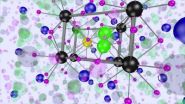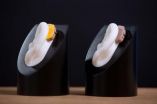(Press-News.org) D-Wave – a special computing machine with this name has been getting computer scientists and physicists talking for a number of years now. The Canadian technology company of the same name is advertising the machine as a quantum computer. However, whether or not the machine does in fact use quantum effects is the subject of controversial debate amongst experts in the field. If it does, then this would make D-Wave the world's first commercially available quantum computer.
The company sold its system to illustrious customers, piquing the interest of the scientific community and of bloggers and journalists even further. For example, the very first machine was sold to the US arms manufacturer Lockheed Martin in 2011, which provided it to the University of Southern California in Los Angeles for tests. Last year, Google purchased the second machine. D-Wave can solve certain mathematical problems referred to as optimization problems by searching for and finding the state of lowest energy in a system. That is why the technology is of interest to this company.
Analogue device, not a quantum computer
But the question of whether or not D-Wave does in fact use quantum effects is not the only disputed aspect of the machine. Scientists and bloggers have also expressed doubt as to whether the machine can be accurately described as a computer at all. There are also different opinions regarding whether or not it can compute faster than a traditional computer. To find answers to these questions, Matthias Troyer, a professor at the Institute for Theoretical Physics at ETH Zurich, worked together with colleagues at the University of Southern California in Los Angeles and tested the system located there.
In their study, which has now been published in the journal Nature Physics, the Swiss-American team of researchers comes to a conclusion that is not clear cut. On the one hand, the scientists confirm that D-Wave does in fact use quantum effects. However, in other areas the researchers are more critical: "D-Wave is an analogue device, a prototype that can be used to solve optimization problems. It would be more accurate to describe it as a programmable quantum simulation experiment", says Professor Troyer, an internationally recognized expert in the field. "D-Wave is certainly not a universal quantum computer."
Quantum effects, but only momentarily
The researchers came to their conclusions by writing thousands of computing problems of differing complexity and solving each of these one thousand times on three systems: once on D-Wave and twice on a simulation programme for optimization problems that ran on a traditional computer. The simulation programme ran in two modes, where one took quantum effects into consideration and one did not. For each task, the scientists made a note of how often which system delivered the right solution. It turned out that D-Wave behaves in the same manner as the simulation that accounted for quantum effects but differently from the simulation that did not.
The scientists were amazed by this result, because the quantum effects of D-Wave are extremely short-lived, lasting only a few billionths of a second. Physicists describe this as coherence time. Because it generally takes around 500 times longer to solve an optimization problem, most experts assumed that the quantum effects with D-Wave simply could not play any role. And yet they do, as the results of the researchers have shown. "It appears that the quantum effects do not necessarily have to be coherent all of the time in order to have a significance", explains Troyer.
Not faster than a traditional computer
When one considers that research into quantum computers is carried out primarily because of the promise of hugely accelerated computing speeds, then another conclusion arrived at by the researchers is particularly significant, namely that D-Wave is not faster than a traditional computer.
The speed of D-Wave is the subject of intense debate amongst experts in the field, particularly since a publication by a computer scientist at Amherst College caused uproar in May of last year. According to the publication, depending on the computing problem, D-Wave is several thousands of times faster than a traditional computer. The researcher examined a version of D-Wave that almost corresponds to the current version, in existence for one year, with a computing capacity of 512 quantum bits (qubits). By contrast, the study carried out by the researchers from ETH Zurich is based on a predecessor version with 108 qubits.
"Not only have we demonstrated that a traditional computer is faster than the 108-bit version of D-Wave", Troyer responds. "We also used a traditional computer to solve the same problems that can be solved by the new 512-qubit version or hypothetically even higher-performing machines." When these findings are compared with those of the researcher from Amherst College, it becomes clear that D-Wave is consistently slower than a traditional computer for the tests performed. According to Troyer, the problem with the Amherst study is that it compared fast algorithms for D-Wave with slower algorithms for traditional computers. "We developed optimized algorithms for traditional computers. This allows us to match even the current 512-qubit version of D-Wave", explains Troyer. "Nobody knows at present whether a future quantum system like D-Wave with more qubits will offer any advantages over traditional systems. This is an important question, and we are currently using experiments on the 512-qubit machine to find the answer."
[Box:]
Quantum annealing with D-Wave
An imperfect crystal structure made of metals or glass can be improved by heating the material until it glows and then cooling it in a controlled environment. In the hot material, the atoms have a certain freedom of movement and can realign in a more refined crystal lattice. This craft technique is thousands of years old and called annealing. A comparable method has also been in use for the past 30 years in computer science as an optimization process and is called annealing as well.
A typical question that can be answered using this method is the search for the lowest point of a landscape. To understand this better, it is possible to imagine a thought experiment where a sphere located in a landscape is subjected to jolts depending on temperature. At high temperatures, the sphere can hop around the entire landscape. The lower the temperature, the harder it is for the sphere to cross mountains. If an experiment is repeated several times, starting with high temperatures and slowly cooling, at the end of the experiments the sphere will frequently be found at the lowest point of the landscape.
When the D-Wave system solves an optimization problem, it uses a similar procedure. In addition, quantum physics and thus tunnel effects also have a role to play: the sphere (remaining with the above example) is also in a position to tunnel underneath the mountains in the landscape. With D-Wave, however, it is not spheres that are moving. Instead, individual superconducting circuits act as quantum simulations or artificial atoms. For this purpose, the system must be cooled to temperatures of almost absolute zero. The circuits simulate the spin of atoms. There is the spin "up" and the spin "down" as well as (because quantum physics plays a role) superposition of the spins, the state of "both up and down". In the D-Wave circuits, the spins are simulated by the direction in which the electrical current is flowing. Physicists call the optimization procedure used by D-Wave "quantum annealing".
INFORMATION:
Literature reference
Boixo S, Rønnow TF, Isakov SV, Wang Z, Wecker D, Lidar DA, Martinis JM, Troyer M: Evidence for quantum annealing with more than one hundred qubits. Nature Physics, 2014, 10: 218-224, doi: 10.1038/nphys2900 [http://dx.doi.org/10.1038/nphys2900]
Innovative computer under scrutiny
2014-03-18
ELSE PRESS RELEASES FROM THIS DATE:
NASA satellite sees Tropical Cyclone Gillian return to remnant low status
2014-03-18
NASA's Aqua satellite captured a visible image of Tropical Cyclone Gillian's remnants in the southern Arafura Sea today, as it passes north of Australia's "Top End."
During the week of March 10, Tropical Cyclone Gillian formed in the northern Gulf of Carpentaria and made a brief landfall on the Western Cape York Peninsula, weakening to a remnant low. After re-emerging in the Gulf, Gillian became a tropical storm again and by March 17 had again weakened to a remnant low as it exited the Gulf and moved into the Arafura Sea.
The MODIS or Moderate Resolution Imaging Spectroradiometer ...
Will health care reform require new population health management strategies?
2014-03-18
New Rochelle, NY, March 17, 2014–In response to the 2010 Affordable Care Act, employers may no long offer traditional employee health care benefits as they protect themselves from rising health care costs and seek to minimize their risk. How the shifting landscape of health care coverage will impact population health management providers, employers, and employees is the focus of a commentary in Population Health Management, a peer-reviewed journal from Mary Ann Liebert, Inc., publishers. The article is available free on the Population Health Management website at http://www.liebertpub.com/pop.
Bruce ...
Climatologists offer explanation for widening of Earth's tropical belt
2014-03-18
RIVERSIDE, Calif. — Recent studies have shown that the Earth's tropical belt — demarcated, roughly, by the Tropics of Cancer and Capricorn — has progressively expanded since at least the late 1970s. Several explanations for this widening have been proposed, such as radiative forcing due to greenhouse gas increase and stratospheric ozone depletion.
Now, a team of climatologists, led by researchers at the University of California, Riverside, posits that the recent widening of the tropical belt is primarily caused by multi-decadal sea surface temperature variability in the ...
Strengthening learning in children: Get outside and play
2014-03-18
University of Cincinnati researchers are reporting on the educational and health benefits of specially created outdoor play environments for children. Victoria Carr, a UC associate professor of education and director of the UC Arlitt Child and Family Research and Education Center, and Eleanor Luken, a former UC research associate for the Arlitt Center and current doctoral student at City University of New York, take a look at this growing trend around the world in an article published this month in the International Journal of Play.
Typically called playscapes, these ...
Bright future for protein nanoprobes
2014-03-18
The term a "brighter future" might be a cliché, but in the case of ultra-small probes for lighting up individual proteins, it is now most appropriate. Researchers at the U.S. Department of Energy (DOE)'s Lawrence Berkeley National Laboratory (Berkeley Lab) have discovered surprising new rules for creating ultra-bright light-emitting crystals that are less than 10 nanometers in diameter. These ultra-tiny but ultra-bright nanoprobes should be a big asset for biological imaging, especially deep-tissue optical imaging of neurons in the brain.
Working at the Molecular Foundry, ...
First guidelines for patients with pulmonary hypertension in sickle cell disease
2014-03-18
(Boston) –Boston Medical Center (BMC) and Boston University School of Medicine (BUSM) physicians have helped create the first set of clinical guidelines for treating patients with pulmonary hypertension in sickle cell disease. Elizabeth Klings, MD, director of the pulmonary hypertension inpatient and education program at BMC and associate professor of medicine at BUSM, spearheaded the development of these guidelines, which are published in the American Journal of Respiratory and Critical Care Medicine.
Several studies conducted in the past decade have demonstrated that ...
Moffitt researchers discover new mechanism allowing tumor cells to escape immune surve
2014-03-18
The immune system plays a pivotal role in targeting cancer cells for destruction. However, tumor cells are smart and have developed ways to avoid immune detection. A collaborative team of researchers at Moffitt Cancer Center recently discovered a novel mechanism that lung cancer cells use to block detection by a type of immune cell called a natural killer cell (NK cell).
NK cells find and destroy virally infected cells and also play an important role in detecting and killing tumor cells. However, tumors produce high amounts of a protein called Transforming Growth ...
Reducing anxiety with a smartphone app
2014-03-18
Playing a science-based mobile gaming app for 25 minutes can reduce anxiety in stressed individuals, according to research published in Clinical Psychological Science, a journal of the Association for Psychological Science.
The study suggests that "gamifying" a scientifically-supported intervention could offer measurable mental health and behavioral benefits for people with relatively high levels of anxiety.
"Millions of people suffering from psychological distress fail to seek or receive mental health services. A key factor here is that many evidence-based treatments ...
Only 1 fifth of people with hearing problems wear a hearing aid
2014-03-18
Just a fifth of people with hearing problems wear a hearing aid, a study by The University of Manchester has found.
The study, published in the journal Ear and Hearing, looked at the habits of 160,000 people in the UK aged 40 to 69 years. It found 10.7 per cent of adults had significant hearing problems when listening to speech in the presence of background noise - but only 2.1 per cent used a hearing aid.
One in 10 middle aged adults had substantial hearing problems and were more likely to be from a working class or ethnic minority background.
Dr Piers Dawes, from ...
Scent of the familiar: You may linger like perfume in your dog's brain
2014-03-18
An area of the canine brain associated with reward responds more strongly to the scents of familiar humans than it does to the scents of other humans, or even to those of familiar dogs.
The journal Behavioural Processes published the results of the first brain-imaging study of dogs responding to biological odors. The research was led by Gregory Berns, director of the Center for Neuropolicy at Emory University.
"It's one thing when you come home and your dog sees you and jumps on you and licks you and knows that good things are about to happen," Berns says. "In our experiment, ...




